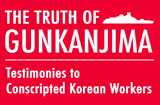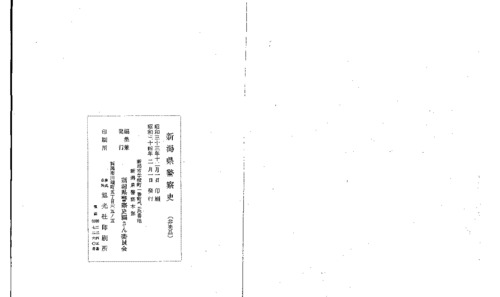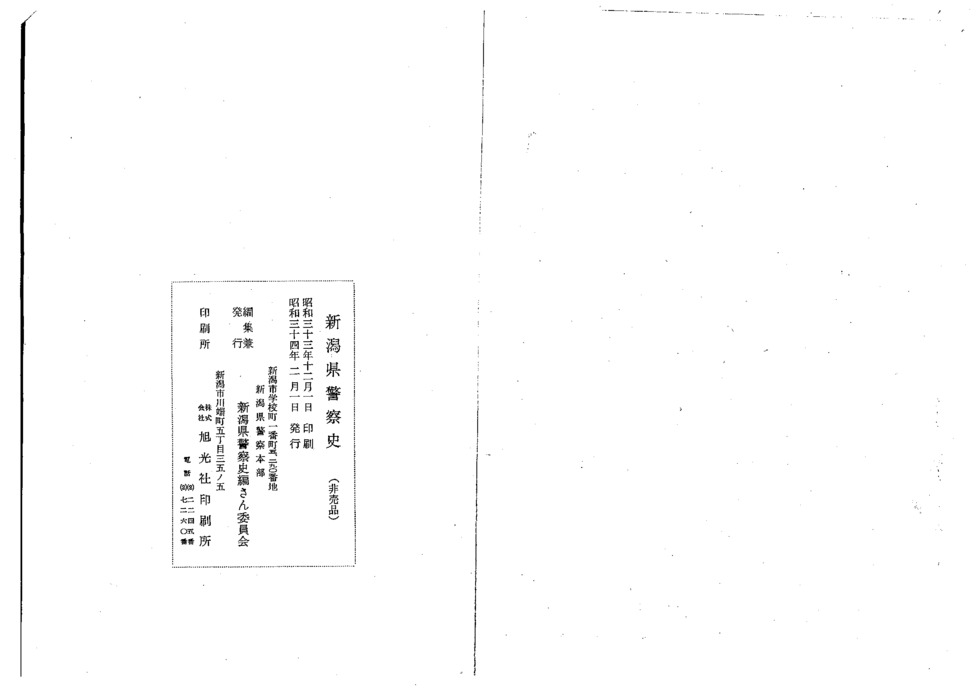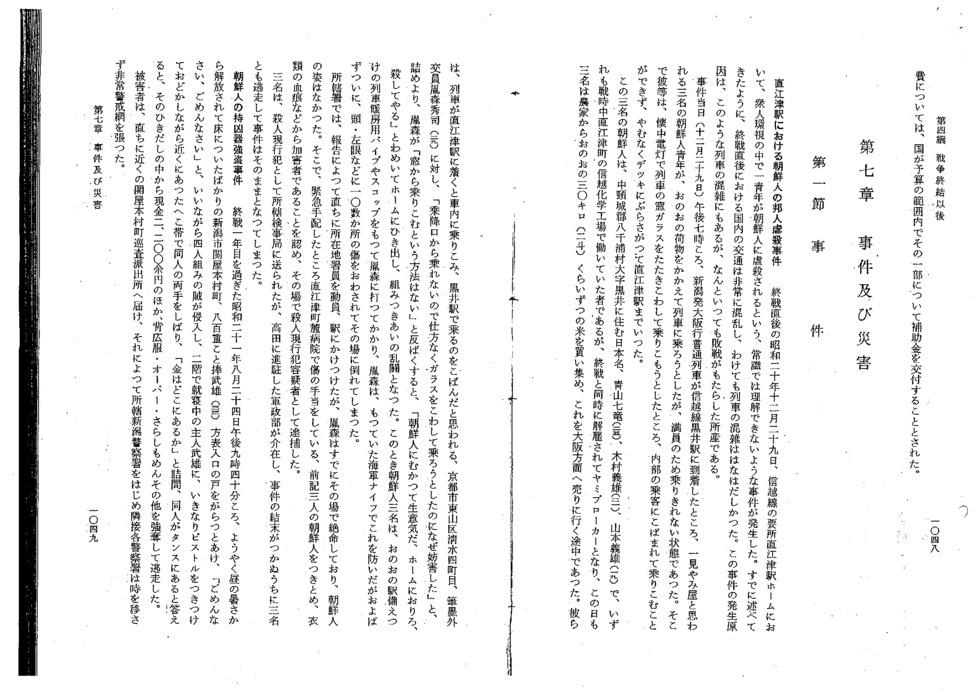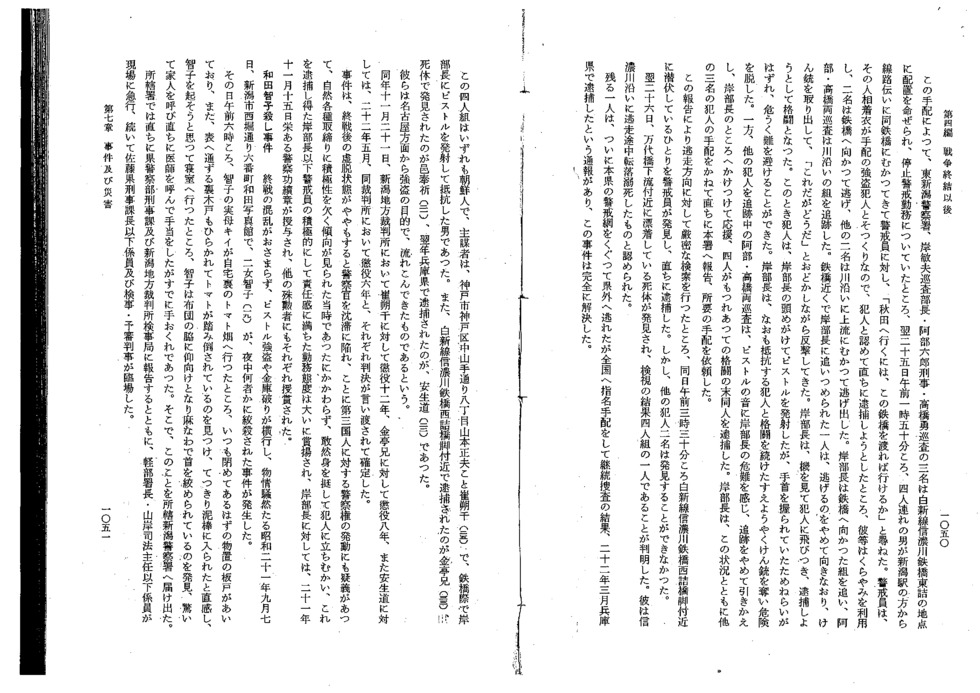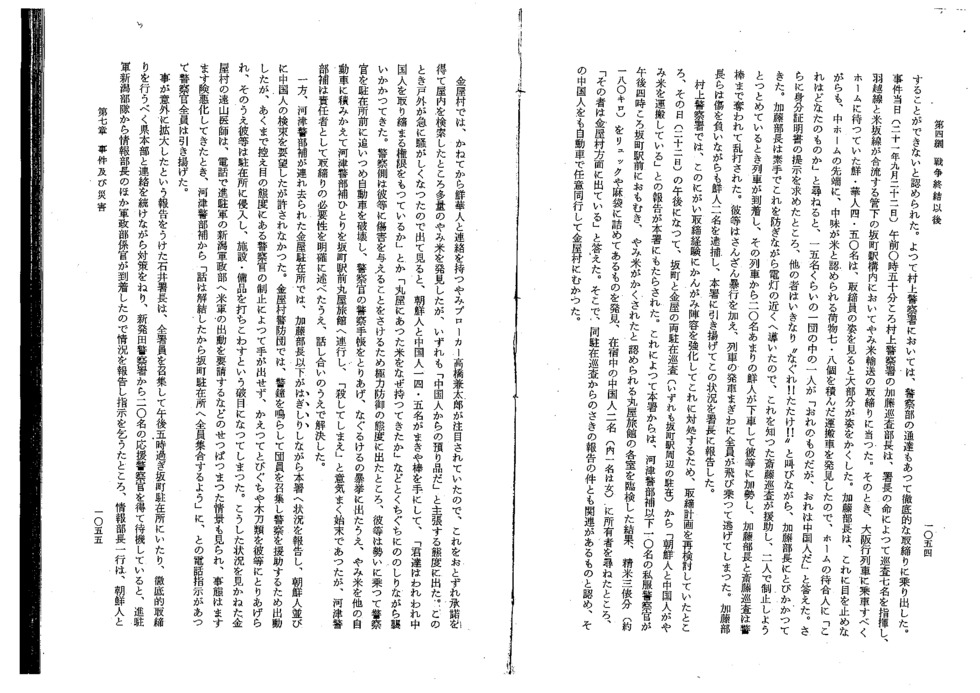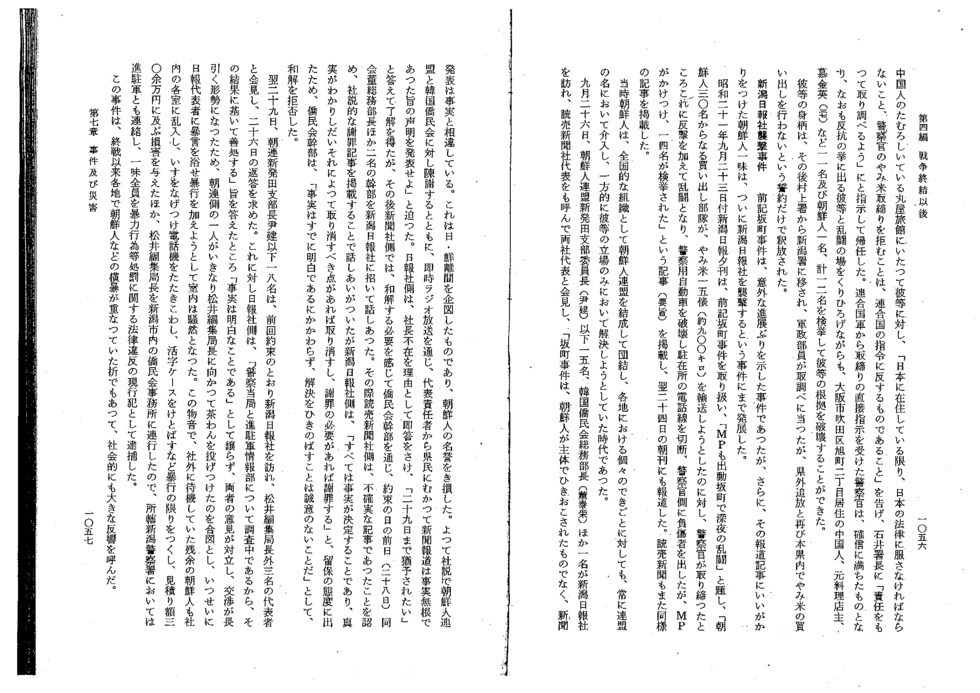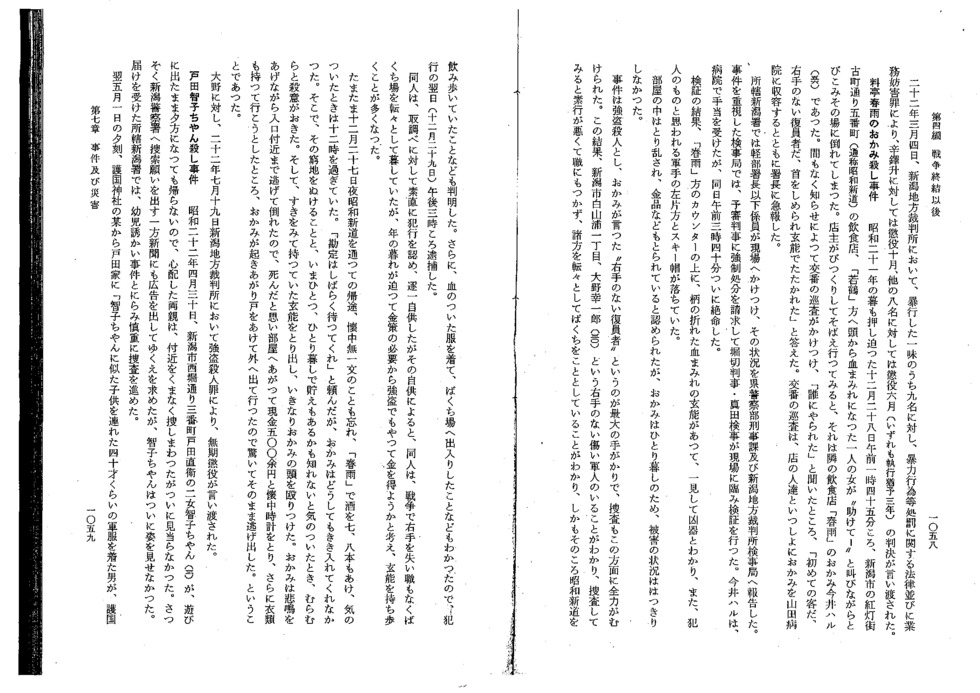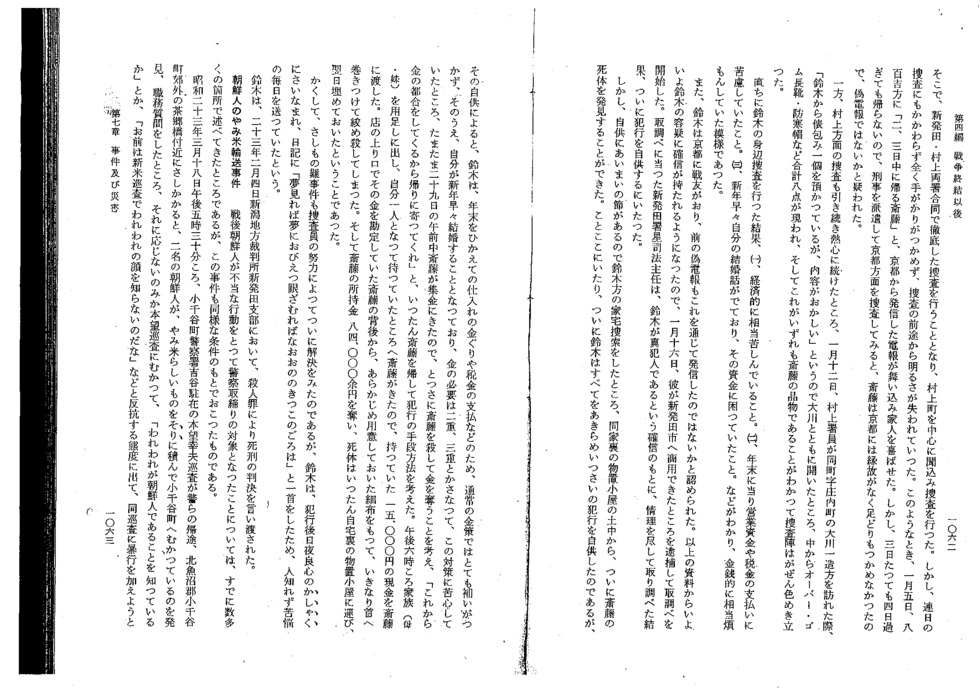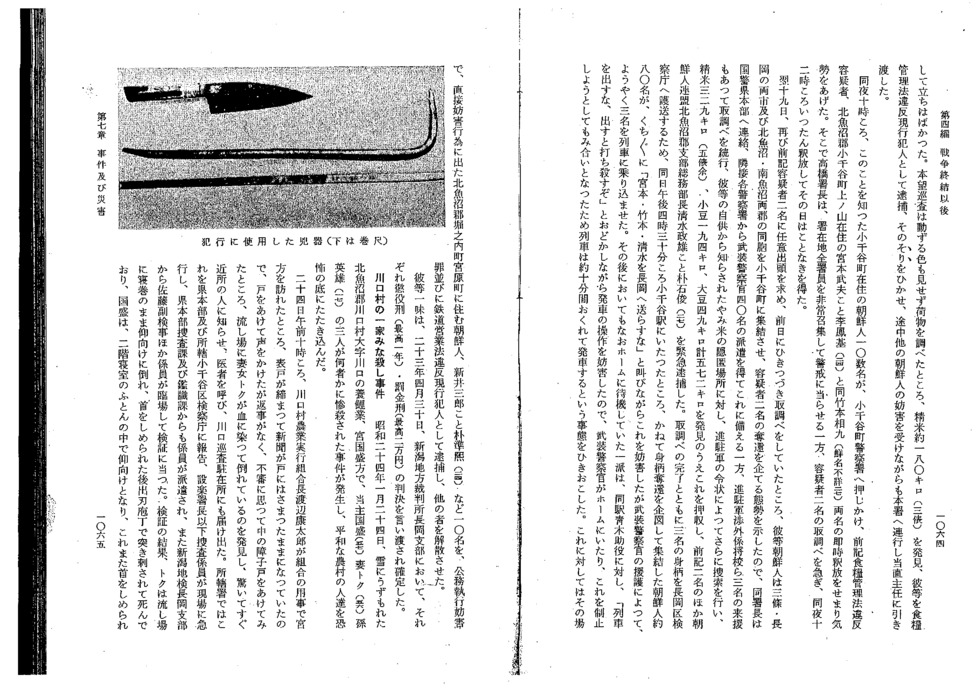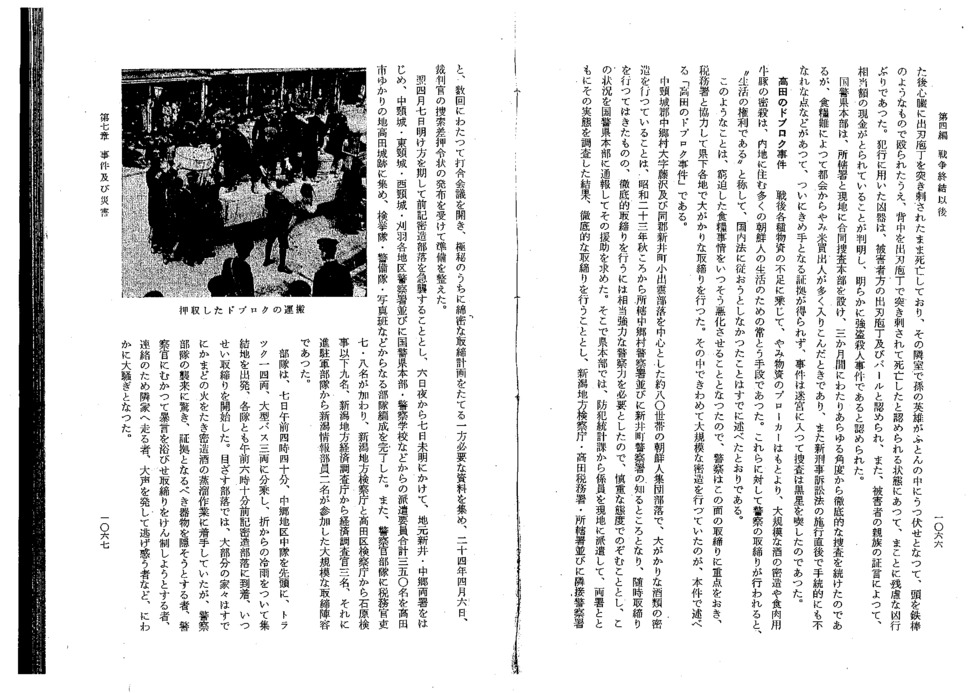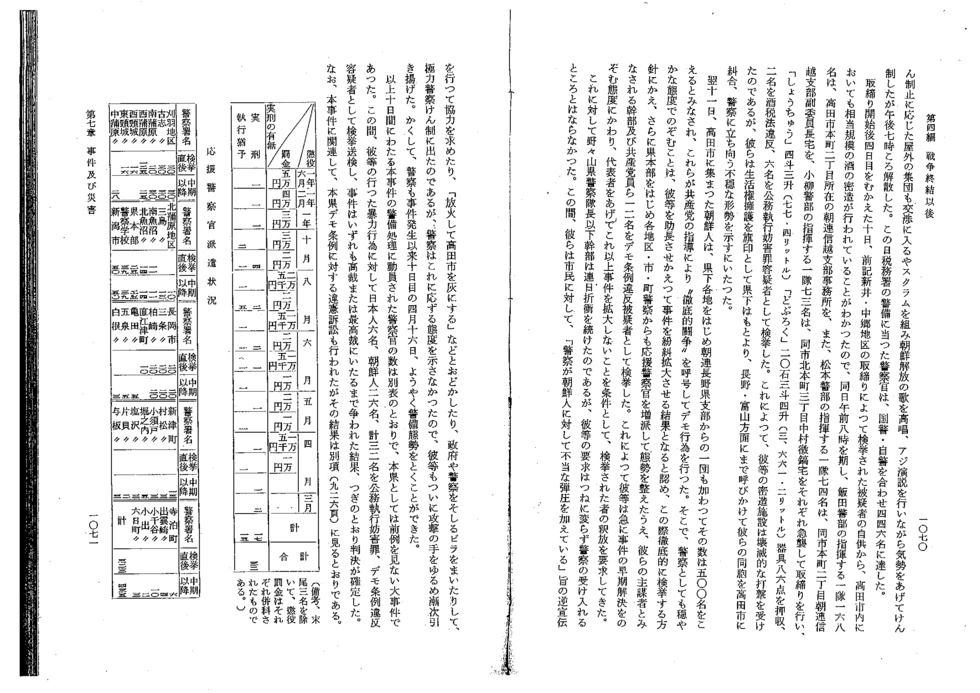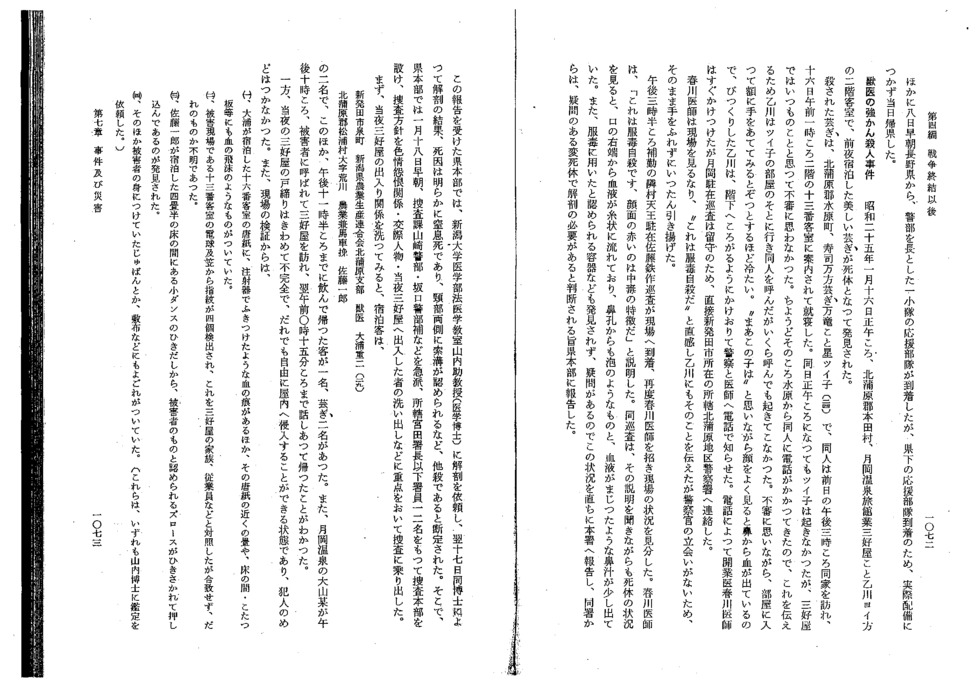Page 1
Page 2
Page 3
Page 4
Page 5
Page 6
Page 7
Page 8
Page 9
Page 10
Page 11
Page 12
Page 13
December 22, 2017
Niigata Prefectural Police History
Classification code: III-002
Publication year: 1959
Chapter VII Incidents and Disasters Section 1 Incidents
Author: Niigata Prefectural Police History Editing Committee
Others Other Documents Police History
Niigata Prefectural Police History
Chapter VII Incidents and Disasters
Section 1 Incidents
Murder of a Japanese Man by Koreans at Naoetsu Train Station
On December 29, 1945, just after the war had ended, a senseless incident occurred in which a young man was killed by Koreans in public on a platform at Naoetsu Train Station, which is a key location on the Shinetsu Line. Domestic transportation was extremely chaotic just after the war ended, as noted above, and in particular, trains were very crowded. One of the causes of this incident was such congestion on the trains, but above all, it resulted from Japan’s defeat in the war.
On the date of the incident (December 29), at around 7:00 p.m., when the local train from Niigata to Osaka arrived at Kuroi Station on the Shinetsu Line, three young Koreans who at a glance looked like black-market traders tried to get on the train, each carrying his own luggage, but they could not board the train because it was full. They then tried to get on by breaking a glass window with a flashlight, but passengers on the train refused to let them in. Having no other choice, they held on to the outside deck, and the train proceeded to Naoetsu Station.
These three Koreans had the Japanese names Nanaryu Aoyama (25), Yoshio Yonemura (21), and Yoshio Yamamoto (19). They lived in Oaza-kuroi, Yachiho Village, Nakakubiki District, and had all worked at the Shinetsu Chemical factory in Naoetsu Town during the war. They were let go from their jobs at the end of the war and became black-market dealers. On this day as well, the three had each bought up about 30 kilograms (2 to) of rice from various farmers and were on their way to sell the rice in Osaka. When the train arrived at Naoetsu Station, they entered the train car and approached Hideshi Tanemori (29), a stationery salesman from Kiyomizu 4-chome, Higashiyama Ward, Kyoto City, who they thought had prevented them from boarding the train at Kuroi Station, and said, “Why did you block us from entering when we broke the glass and tried to get in because we couldn’t get in through the door?” And when Tanemori challenged them saying, “Coming through the window is not a way to get on the train,” they pulled him onto the platform yelling “How dare you be impertinent to Koreans. Get down onto the platform. We will kill you,” and a fight broke out. The three Koreans hit Tanemori with train heating pipes and shovels kept at the station. Tanemori tried to defend himself with a Navy knife he was carrying, but that was not enough, and he was soon covered with more than 10 injuries to his head and left eye, and fell to the ground.
In response to a report of the incident, the police station with jurisdiction over the area immediately deployed personnel under its command, and they arrived at the station, but Tanemori was already dead at the site, and there was no sign of the Koreans. While conducting a search, the three Koreans were found receiving care for wounds at the Fumoto Hospital in Naoetsu Town. They were recognized as the assailants from the bloodstains on their clothes and other signs, and arrested right there on suspicion of murder.
The Koreans were sent to the public prosecutor’s office with jurisdiction over the area to be tried for murder, but the Occupation Forces military government in Takada intervened, the three escaped before the incident was settled, and the case was left unresolved.
Robbery by Koreans using a Handheld Weapon
At around 9:40 p.m. on August 24, 1946, a year after the war ended, a gang of four robbers abruptly threw open the front door of the home of Takeo Sasage (33) of Yaoju, Sekiya Honson Town, Niigata City, who had just gone to bed as the heat of the day had finally eased. They burst into the house saying, “excuse us excuse us,” suddenly pointed a pistol at Takeo, the head of the household, who was asleep on the second floor, tied his hands with a sash that was nearby while threatening him, and asked him, “Where is your money?” When he responded that the money was in the dresser, they took more than 2,200 yen in cash, a suit, a coat, and some bleached cotton cloth, and ran away.
The victim immediately reported the incident to the nearby Sekiya Honson Town Police Box, and in response the Niigata Police Station, which had jurisdiction over the area, and other adjacent police stations promptly set up a police dragnet.
As part of this search, at the Higashi Niigata Police Station, three police officers—Sergeant Toshio Kishi, Detective Rokoro Abe, and Patrolman Isamu Takahashi—were deployed to the east end of the Shinanogawa River railway bridge on the Hakushin Line, where they stood guard. And at around 1:50 a.m. on the 25th a group of four men came walking along the railway from the direction of Niigata Station toward the bridge and asked the guards, “Can we get to Akita by crossing this bridge?” When the guards recognized them as the robbers, because their features and clothes exactly matched those of the robbers being searched for, and moved to immediately arrest them, the robbers made use of the darkness. Two of them ran towards the bridge and the other two ran upstream along the river. Sergeant Kishi ran after the pair moving toward the bridge, while Detective Abe and Patrolman Takahashi chased after the pair moving along the river. When Kishi caught up to one of the robbers near the bridge, the robber stopped running, faced him and drew his gun, and took the offensive, brandishing his weapon. Kishi saw an opportunity, jumped on the criminal, tried to arrest him, and they fought. The criminal fired his pistol aiming at Kishi’s head, but he missed because Kishi had grabbed his wrist, and thus escaped the worse. Kishi continued fighting with the criminal, who was still resisting. and finally managed to take the gun and escape danger. Meanwhile Abe and Takahashi, who were chasing after the other criminals, heard the gun shot, sensed that Kishi was in danger, stopped their chase, and ran back to help Kishi. They joined in the fight, and the criminal was finally arrested. Kishi immediately reported this situation to the Niigata Prefectural Police and asked them to launch a search for the other three criminals.
A meticulous search was carried out in the direction where they had run, and around 3:30am the same day a guard discovered one of them hiding near the pier of the west end of the Shinanogawa River Railway Bridge on the Hakushin Line, and immediately arrested him, but the police were unable to find the other two criminals.
On the following day, the 26th, a washed-up body was found downstream from the Bandai Bridge, and the autopsy determined it was one of the criminals. It was concluded he had fallen while running along the Shinanogawa River and drowned.
The one remaining criminal managed to evade the Niigata police search net and escaped outside the prefecture. After expanding the search for the suspect nationwide and continuing with the investigation, it was reported that he was arrested in Hyogo Prefecture in March 1947. The incident was thus completely resolved.
This group of four were all Koreans. The leader was Masao Yamamoto, also known as 崔朔千 (Choe Sak-cheon) (25) who resided in Nakayamate Dori 8-chome, Kobe Ward, Kobe City and who fired the pistol at Sergeant Kishi and resisted near the railway bridge. The man arrested near the pier of the west end of the Shinanogawa River Railway Bridge on the Hakushin Line was 金亭兄(Kim Jeong-hyeong) (33), the one whose body was discovered was 邑奉祈 (Eup Bong-gi) (21), and the one arrested the following year in Hyogo Prefecture was 安生道 (An Saeng-do) (22).
It is said they came from the Nagoya area for the purpose of robbery.
On November 21 of the same year, the Niigata District Court sentenced 崔朔千 (Choe Sak-cheon) to 12 years in prison and 金亭兄 (Kim Jeong-hyeong) to eight years. Also, in May 1947, the same court sentenced 安生道 (An Saeng-do) to six years in prison. In this manner, the sentences on all three of them were handed down and finalized.
In this incident, there was high praise for the positive and responsible work attitude of Sergeant Kishi and the other guards who bravely risked their lives to stand up against the criminals and arrested them, despite the apathy following the end of the war, in which policemen easily fell into inactivity amidst doubts regarding the exercise of police authority with respect to nationals of so-called third countries (i.e., Taiwan and Korea), and the natural tendency toward a lack of proactivity in various types of policing. Sergeant Kishi was given the honorable Police Merit Award on November 15, 1946 and the other officers who had distinguished themselves were also given awards.
- 1053-1058
Sakamachi Incident
The so-called Sakamachi Incident, in which police officers fought with Chinese and Koreans in a crackdown on the transportation of black-market rice, took place at Sakamachi Train Station on the Uetsu Line on September 22, 1946, a year after the war ended.
Chinese and Koreans who were brought into Japan to deal with the domestic labor shortage during the war and others who were already living inside Japan suddenly changed their attitude at the end of the war. They took advantage of the shortage of police officers and uncertainty about whether domestic laws applied to them. They openly engaged in trading of black-market rice and illegal production of alcohol, and became a “cancer” on the enforcement of economic regulations. However, while the application of laws on policing was not clear, because policing was necessary in practice, it was always controversial. It was truly an era when power ruled, as ultimately situations were resolved by the relative strengths of the parties involved.
At that time, the Association of Koreans in Japan had an office in Shibata City in the Kaetsu region of Niigata Prefecture. Under their efforts, about 200 Koreans were living around Honai Village and Kanaya Village in Iwafune District, and Kinoto Village in Kitakanbara District. They gathered black-market rice from around Yamagata Prefecture and the Iwafune District and sent it by train toward Kansai, mostly from the Sakamachi and Hirakida train stations. They acted brazenly, as if no one was there. Meanwhile, the domestic food situation was extremely serious, and controls over the distribution of food were made even stronger than during the war by order of the Occupation Forces. The complete delivery of rice by farmers was an order of the greatest importance and the police made every effort to encourage deliveries as part of that overriding imperative.
At that time, it is said that 50 sacks of black-market rice were shipped from Sakamachi Train Station each day. The police realized that without stopping this completely, the complete delivery of rice by farmers in their jurisdiction would be impossible. Accordingly, the Murakami Police Station received a notice from the Prefectural Headquarters Police Department and they began an effort to rigorously enforce the law.
On the date of the incident (September 22, 1946), at around 12:50 a.m., following the order of the police station chief, Sergeant Kato of the Murakami Police Station and seven officers under his command went to Sakamachi Station, which is where the Uestu Line joins with Yonesaka Line, to police the transportation of black-market rice within their jurisdiction. When they arrived, there were 40-50 Koreans and Chinese waiting on the platform to board a train headed for Osaka, and most of them disappeared when they saw the police officers. While watching this, Sergeant Kato discovered a cart at the front end of the center platform loaded with seven or eight sacks which he recognized as filled with rice. When he asked the people waiting on the platform “Who do these belong to?” one person in a group of around 15 replied, “It is mine, I am Chinese.” When Kato then asked the man to show his ID papers, the other men suddenly attacked him, while screaming “Beat him, hit him!” Defending himself with his bare hands, Sergeant Kato led them near a light, and noticing this, patrolman Saito came to his aid. While the two were trying to hold them off a train arrived, more than 20 Koreans got off and joined the others, and Kato and Saito were hit over and over and had their nightsticks taken away. After their merciless violence, the Koreans and Chinese all boarded the train just before it left and escaped. Nevertheless, while covered with wounds, Kato and his men arrested two of the Koreans, returned to the police station. and reported the situation to the chief.
On the afternoon of that day (the 22nd) at the Murakami Police Station, while the police were reflecting on this bitter experience in law enforcement and re-examining their plans to deal with the situation by reinforcing their ranks, officers stationed at both the Sakamachi and the Kanaya police boxes (both nearby Sakamachi Station) reported to the station that there were some Koreans and Chinese transporting black-market rice. In response, at around 4:00 p.m., Assistant Inspector Kawazu and 10 plainclothes police officers headed from the police station toward Sakamachi Station. As a result of an on-site inspection of each room at the Maruya Inn, where police suspected black-market rice was hidden, three sacks of polished rice (about 180 kilograms) were discovered inside rucksacks and jute sacks. When the police asked two Chinese staying at the inn (one of whom was a woman) who owned the goods, they replied that the owner had gone out toward Kanaya Village. The police recognized this had something to do with the above-mentioned reports from the officers, so they had the Chinese voluntarily accompany them by car to Kanaya Village.
At Kanaya Village, Kentaro Takahashi, a black-market dealer who had connections with Koreans and Chinese, had been noticed for some time. When they visited him and searched inside his house with his permission, they discovered a large volume of black-market rice, but he said these were all goods he was holding for Chinese. There was a sudden commotion outside, and when the police came out there were 14 or 15 Koreans and Chinese with pieces of firewood and sticks in their hands who attacked them while shouting “Do you have any authority to police us Chinese?” and “Why did you bring rice from the Maruya Inn?” To avoid inflicting any harm on them, the police took as defensive a stance as possible, but the Koreans and Chinese took advantage of the situation and chased the police officers to the police box, destroyed a car, took away their police IDs, and violently beat and kicked them. The assailants moved the black-market rice into another car and brought only Assistant Inspector Kawazu with them to the Maruya Inn in front of Sakamachi Station, and were working themselves up to kill him, but Kawazu, as the person responsible, clearly explained the need to enforce the law, and resolved the situation through dialogue.
Meanwhile, at the Kanaya Police Box where Kawazu was taken from, Sergeant Kato and his subordinates sent a report to the Murakami Police Station while grinding their teeth in anger. They requested the arrest of the Koreans and Chinese, but that was not permitted. At the Kanaya Village Civil Defense Unit, the warning bell was rung and members assembled to assist the police, but they could not act because they were stopped by the restrained stance of the police, who conversely took away their fire hooks, wooden swords, and other weapons, and they wound up breaking into the police box and destroying furnishings and equipment. When the situation was getting so urgent that, unable to put up with this, Dr. Toyama of Kanaya Village contacted the Occupying Forces military government in Niigata by telephone, asking for the U.S. Armed Forces to be mobilized, and the conditions became more and more tense. Assistant Inspector Kawazu gave an order on the phone, saying, “The situation has been resolved, so you should all report to the Sakamachi Police Box,” and the police officers all withdrew.
Police Station Chief Ishii, who received reports that the situation had worsened beyond expectations, had all his officers assemble, went to the Sakamachi Police Box after 5:00pm, and planned measures to thoroughly enforce the law while remaining in contact with the prefectural police headquarters. He was waiting with 20 police officers sent as reinforcements from Shibata Police Station when an intelligence officer and a military government officer of the Occupation Forces in Niigata arrived. Ishii reported on the conditions and asked for instructions. The intelligence officer and his party went to the Maruya Inn where the Koreans and Chinese were gathered and told them, “As long as you reside in Japan, you must follow Japanese law. Refusing the crackdown on black-market rice by the police violates the orders of the Allied Powers.” They instructed Police Station Chief Ishii to “take responsibility and investigate,” and returned to their base. Having received direct orders from the Allied Powers to enforce the law, the police officers were filled with confidence, and while fighting with the suspects who were still resisting, they managed to arrest 11 Chinese beginning with former restaurant owner 慕金英, who lived in Asahimachi 2-chome, Suita Ward, Osaka City, and one Korean, and destroyed their base.
The suspects were subsequently transferred from the Murakami Police Station to the Niigata Police Station, military government officials investigated, and the suspects were released with a promise that they would be deported outside Niigata Prefecture and would never again buy black-market rice inside the prefecture.
Attack on the Niigata Nippo Newspaper Company
The above-mentioned Sakamachi Incident was an incident that took unexpected turns. It led to another incident in which a gang of Koreans who took issue with its coverage in the news attacked the Niigata Nippo Newspaper Company.
The September 23, 1946 evening edition of the Niigata Nippo reported on the above-mentioned Sakamachi Incident with an article entitled “Late Night Fight at Sakamachi – MPs Mobilized” which said (to summarize), “When the police raided a group of 30 Korean buyers trying to ship 15 sacks (about 900 kilograms) of black-market rice, the Koreans fought back causing a scuffle, destroyed a police car, cut the phone line to the police box, and injured some police officers, but MPs arrived and 14 Koreans were arrested.” This article was also published in the morning edition the following day on the 24th. The Yomiuri Shimbun newspaper printed a similar article as well.
At that time, Koreans had banded together through the Association of Koreans in Japan as a national organization. They always intervened in individual incidents in each region in the name of the association and acted to resolve incidents unilaterally.
On September 26, the Chairman of the Shibata Branch of the Association of Koreans in Japan (尹建(Yun Geon)) with a group of 15 persons, together with the General Affairs Manager (蕭泰栄 (So Tae-yeong) and one other member of the Korean Expatriates Association, visited the Niigata Nippo Newspaper, called a representative from the Yomiuri Shimbun as well, and met with representatives of both newspaper companies. He said, “The Sakamachi Incident was not mainly caused by Koreans, and the newspaper coverage is at odds with the facts. This coverage was an effort to drive a wedge between Japan and Korea, and it insulted the honor of the Korean people. So, we want you to apologize to the Association of Koreans in Japan and the Korean Expatriates Association in an editorial, and immediately have the responsible representative announce on the radio to the people of the prefecture that the newspaper coverage had no basis in fact.” The Niigata Nippo avoided giving an immediate answer by saying that the president was not there, asked for them to wait for an answer until the 29th, and they agreed. This newspaper company saw the need for reconciliation, and through an executive of the Korean Expatriates Association invited General Affairs Manager 蕭(So) and two executives of that Association to the Niigata Nippo newspaper company the day before the promised date (on the 28th) and held discussions. At that time, the Yomiuri Shimbun admitted that their were uncertainties about their story and agreed to print an editorial-type apology article, but the Niigata Nippo deferred a final decision, saying “Everything will be determined by the facts. and when the truth is known, if there are items that must be retracted, they will be retracted then, and if an apology is required, an apology will be made.” The executives of the Korean Expatriates Association refused to reconcile with the Niigata Nippo, saying, “Delaying resolution even though the facts are already clear is not acting in good faith.”
The following day on the 29th, the Association of Koreans in Japan Shibata Branch Chairman 尹建 (Yun Geon) and 18 others came to the Niigata Nippo Newspaper Company as previously arranged, met with Editor-in-Chief Matsui and three other representatives, and sought an answer from the 26th. The Niigata Nippo responded, saying “We are checking with the police authorities and the Occupation Forces Intelligence Division, and we will take proper measures based on the results of those investigations.” The Koreans refused to yield, saying that the facts were obvious, and as the opinions of the two sides were opposed the negotiations grew prolonged. Then, when one of the Koreans suddenly threw a tea cup at Editor-in-Chief Matsui, they all began cursing and assaulting the Niigata Nippo representatives, throwing the room into an uproar. With this commotion, other Koreans who had been waiting outside the company burst into each room of the building, threw chairs, broke telephones, kicked cases of type. and committed all types of violence, causing damages estimated at more than 300,000 yen. Then they brought Matsui to the Korean Expatriates Association office in Niigata City, so the Niigata Police Station, which had jurisdiction over the area, contacted the Occupation Forces and arrested all of them for committing acts of violence.
This incident took place at a time when there many incidents of violence committed by Koreans in various places after the end of the war and had a major impact on society.
On March 4, 1947, during sentencing for nine members of the gang which committed violence, the Niigata District Court sentenced 辛鐸升 (Sin Tak-seung) to 10 months in prison and the other eight to six months in prison (all sentences suspended for three years) for violation of the law on acts of violence and for obstruction of business.
Incident Involving Transport of Black-Market Rice by Koreans
As already noted in above, unlawful behavior by Koreans was frequently the targeted by police after the war. This incident also took place under similar conditions.
On March 18, 1948 at around 5:30pm, when Patrolman Yukio Honmo of the Ojiya Town Police Station Furuya Police Box approached the Chagobashi Bridge at the outskirts of Ojiya Town, Kitauonuma District on his way back from patrol, he discovered two Koreans carrying what appeared to be black-market rice on a sled moving toward Ojiya Town. When he questioned them, they not only failed to answer, but took a defiant attitude, turned toward him, and said “Do you know that we are Koreans?” and “You don’t know our faces because you are a newcomer.” They blocked his way in order to assault him. Honmo checked their bags without moving or showing any agitation, and discovered about 180 kilograms (three sacks) of polished rice. He arrested them in the act for violation of the Staple Food Control Act, had them pull the sled, brought them to the police station while being obstructed on the way by other Koreans, and turned them over to the officer on duty.
Around 10:00pm that night, more than 10 Koreans living in Ojiya Town who had come to know the arrests burst into the Ojiya Town Police Station and demanded the immediate release of Takeo Miyamoto, also known as 李鳳基 (Yi Bong-gi), (24) and Sokyu Takemoto (Korean name unknown, 27), who lived in Uenoyama, Ojiya Town, Kitauonuma District; the two had been arrested on suspicion of violating the Staple Food Control Act. Police Station Chief Takahashi summoned all the members of the police station as an emergency measure and had them stand guard, hurried the questioning of the two suspects, and released them around midnight. The day ended without incident.
On the following day, the 19th, when the police had the two above-mentioned suspects return to the police station voluntarily and continued their investigation from the previous day, local Koreans asked other Koreans from Sanjo City, Nagaoka City, the Kitauonuma District and the Minamiuonuma District to assemble in Ojiya Town, and made clear their intention to take back the suspects. So, Takahashi contacted the National Rural Police Prefectural Headquarters, and they dispatched 40 armed police officers from neighboring police stations and began to prepare. He continued the investigation along with three personnel from the Occupation Forces who came to help, including a liaison officer. With a warrant from the Occupation Forces, they searched a black- market rice hiding place which they learned about from the suspects’ confessions. They found and confiscated a total of 572 kilograms of foodstuffs with 329 kilograms (over five sacks) of polished rice, 194 kilograms of adzuki beans, 49 kilograms of soybeans and, in addition to the above-mentioned two suspects, immediately arrested Masao Shimizu, also known as 朴石俊 (Bak Seok-jun (27), who was the General Affairs Division Manager of the Kitauonuma District Branch of the Association of Koreans in Japan. When they arrived at Ojiya Train Station around 4:30pm upon completion of their investigation to transfer the three suspects to the Nagaoka Ward Public Prosecutor’s Office. about 80 Koreans who had gathered to recapture the suspects began shouting, “Do not have Miyamoto, Takemoto, and Shimizu sent to Nagaoka.” The Koreans interfered, but with the assistance of the armed police officers, they were finally able to put the three suspects onto the train. Even after that, some Koreans who were still waiting on the platform threatened Assistant Station Master Aoki, saying, “Don’t let the train leave. If you do, we will kill you,” interfering with the train’s departure. So, the armed police officers came to the platform, acted to stop this, and a fight broke out. Consequently, the train departed about 10 minutes late. In response, the police arrested 10 Koreans who had directly obstructed the police, including Saburo Arai, also known as 朴準煕 (Bak Jun Hui) (24) of Miyabara, Horinouchi Town, Kitanouma District for obstruction of performance of public duties and violation of the Railway Operation Act, and dispersed the others.
The suspects were all sentenced at the Nagaoka Branch of the Niigata District Court on April 30, 1948 to imprisonment (maximum one year) and fined (maximum 20,000 yen), and their sentences were finalized.
- 1066-1072
Takada Raw Sake Incident
With shortages of all types of materials after the end of the war, many Koreans residing in Japan engaged in brokering black-market goods, large-scale bootlegging of alcohol, and illegal butchering of beef and pork as common ways of earning a living. When police acted to enforce laws against these activities, Koreans refused to follow domestic laws in the name of the right to make a living, as mentioned above.
Such behavior further exacerbated the tight food situation, so police emphasized enforcement in this area and engaged in large-scale raids throughout the prefecture in cooperation with the Tax Office. Among these, the Takada Raw Sake Incident described here was a particularly large-scale bootlegging operation.
From around the autumn of 1948, the Nakago Village Police Station and the Arai Town Police Station, which had jurisdiction over the area, came to learn of a large-scale sake bootlegging operation in a community of 80 Korean families centered on Oaza Fujisawa, Nakago Village, Nakakubiki District and on a second address of Oizumo Hamlet, Arai Town, Nakakubiki District. While they had been enforcing the law as necessary, because full-scale enforcement would require a substantially larger police force, the police had taken a cautious stance. They reported the situation to the prefectural headquarters of the National Rural Police and sought assistance. The headquarters dispatched staff from the Crime Prevention Statistics Section, and after investigating the actual conditions with both police stations, decided to conduct full-scale enforcement. They held several meetings with the Niigata District Public Prosecutor’s Office, the Takada Tax Office, the police stations with jurisdiction over the area and adjacent police stations. They then prepared a detailed plan in secrecy, assembled the necessary materials, and got ready to conduct a raid after a judge issued a search and seizure warrant on April 6, 1949.
The plan was to make a surprise attack on the above-mentioned bootlegging community on the following April 7th at dawn, so from the evening of the 6th until before dawn on the 7th, a total of 350 police officers from the Arai and Nakago local police stations, the Nakakubiki, Higashikubiki, Nishikubiki and Kariwa regional police stations, as well as the National Rural Police Prefectural Headquarters and the Police Academy assembled at the remains of Takada castle associated with Takada City and completed organizing their units, including an arrest unit, guard unit, and photography team. Also, along with these police, there were seven or eight tax officials, nine people from the Niigata District Public Prosecutor’s Office and the Takada Ward Public Prosecutor’s Office led by Prosecutor Ishihara, two economics investigation officers from the Niigata District Economics Investigation Agency, and two intelligence officers from the Occupation Forces in Niigata, so this was a large-scale enforcement formation divided into two companies of police.
They got onto 14 trucks and three large buses, with the Nakago district company at the front, and departed from the assembly location at 4:40 a.m. on the 7th in the cold rain. The companies each arrived at the above-mentioned bootlegging community at 6:10 a.m. and began the raid all at once. In the target community, most of the homes had already lit their fires and had begun the bootleg distilling work. They were surprised by the police raid, and there was great turmoil as some tried to hide utensils that would become evidence, some cursed at the policemen and tried to stop them, some ran to neighboring houses and some ran about screaming trying to escape.
During this time, the raid progressed as planned, with the police carrying out the investigation and confiscating items of evidence, arresting suspects, and photographing the scene. The police gave the Koreans no opportunity to resist, and both companies left at around 8:30 a.m. after completing the arrests of people and confiscating goods that may have been in violation of the Liquor Tax Law as detailed below, and headed for the Nakakubiki District Police Office.
|
Category
Company |
Suspects Arrested |
Items Confiscated |
|||||
|
Japanese |
Koreans |
Shochu |
Unrefined sake |
Raw sake |
Malted rice |
Utensils |
|
|
Nakago District Company |
5 |
26 |
3 koku 3 to 1 sho |
18 koku 4 to 6 sho |
11 koku 0 to 6 sho |
2 koku 0 to 1 sho |
376 items |
|
(595.8 liters) |
(3,323.8 liters) |
(1,990.8 liters) |
|||||
|
Arai District Company |
0 |
13 |
2 koku 1 to 4 sho |
6 koku 0 to 5 sho |
4 koku 4 to 0 sho |
|
115 items |
|
(383.2 liters) |
(1,089 liters) |
(792 liters) |
|||||
|
Total |
5 |
39 |
5 koku 4 to 6 sho |
24 koku 5 to 1 sho |
15 koku 4 to 6 sho |
2 koku 0 to 1 sho |
491 items |
|
(982.8 liters) |
(4,391.8 liters) |
(2,782.8 liters) |
|||||
Note: From Takada Jiken no Gaikyo [Overview of the Takada Incident] (prepared by Nakakubiki District Police Station).
After the completion of the above-mentioned raid, the suspects were brought to the Nakakubiki District Police Station. They were held in the jail, the martial arts gym, and other locations, and the case proceeded as an investigation of violation of the Liquor Tax Law. Meanwhile, other Koreans from the above-mentioned bootlegging community, with assistance from members of the Shinetsu Branch of the Association of Koreans in Japan, started to gather in groups of three and four in front of the Takada City Police Station around 10:40 a.m. on that day, and by noon their numbers had reach more than 200, including women and children. They began to insult the police, and their representatives demanded the release of the suspects. Because the police firmly refused this demand, it appeared that they disbanded once, but from the evening groups of around a dozen each gathered in waves in front of the police station and used offensive language. By 3:00 a.m. on the 8th they had repeated this more than 10 times, and finally threw stones toward the police station building, broke more than 10 window panes, and turned to violence, so the policemen who had been posted on guard arrested four of the Koreans on suspicion of vandalism, and dispersed the others. Also, in the District Police Station Chief’s office, Chief Fujita and Prosecutor Ishihara met with the Koreans’ representatives, and were responding to negotiations demanding release of the suspects, but with this eruption of violence they cut off the negotiations. From around that time, the need to further reinforce the guard was recognized, so reinforcements from each district and city police were requested, and as an emergency measure the National Rural Police Nagano Prefecture Headquarters was also asked to dispatch more police officers as reinforcements.
At around 2:00 p.m. on the 8th, around 200 Koreans assembled in front of the Takada City Police Station, as they had the previous day. They joined together, sang “The Red Flag” to raise their spirits, and once again sent their representatives to demand the release of the suspects. But, because the police refused, they made a plan to intrude on the tax office next time, and disbanded around 7:00 p.m. From that day, leadership from members of the Japanese Communist Party became evident.
After 12:00 p.m. on the following day, the 9th, one Korean woman appeared at the counter of the Takada Tax Office. The police officers who had been posted there, knowing from the previous day’s developments that there would some threatening activity against the tax office, were not concerned at first, also seeing her as just a person who had come on regular business. But after a while 14 or 15 Korean women and children started to gather in front of the tax office. When the surprised tax office workers asked them why they had come, they asked to meet with the superintendent, and when they were told to name a representative, they said they all wanted to meet him. The police officers on guard could not just watch, and when they urged the Koreans to go outside the building, they resisted the police officers, sat down in front of the tax office, and ended up screaming “murderers.” Then around 1:00 p.m., 40 or 50 Koreans (men) arrived, screamed “We want to meet the superintendent,” and tried to get inside the Tax Office. They got into a skirmish with the police officers on guard, and nine police officers, two newspaper reporters, and two Korean women were injured.
Then a group of Koreans who had been waiting for the right moment, numbering as many as 100, finally worked themselves into a frenzy, threw stones at the tax office and got ready to attack. On the police side, 130 police officers who were standing by at the Takada City Police Station were urgently dispatched, took control, and were able to stop this quickly. The Koreans’ representatives and Tax Office Superintendent Shikama began negotiations, but the Koreans’ demand was “Return the items that were confiscated.” Of course, the superintendent did not accept this demand, and since there was no prospect for a negotiated agreement, he ordered the representatives to leave, but they refused. One of them was arrested in the act for breaking into a building and unlawful trespassing, and the others were sent out. During this time, the group outside that had been stopped started to band together when the negotiations started. They boosted their spirits by loudly singing Korean liberation songs and giving propaganda speeches, pressured the police, and then disbanded around 7:00 p.m. The number of police officers guarding the tax office on this day reached a total of 446, with men from the national and municipal police forces.
On the 10th, which was the fourth day since the enforcement action began, the police learned from the confessions of suspects arrested in the above-mentioned raid in the Arai and Nakago districts that there was also a very large alcohol bootlegging operation inside Takada City.
So at 8:00 a.m. that day, a group of 168 police officers under the command of Inspector Iida raided the office of the Shinetsu Branch of the Association of Koreans in Japan in Honcho 2-chome, Takada City, a group of 74 police officers under the command of Inspector Matsumoto raided the residence of the Vice Chairman of the Shinetsu Branch of the Association of Koreans in Japan in Honcho 2-chome, Takada City, and a group of 73 police officers under the command of Inspector Koyanagi raided the residence of Choko Nakamura in Kita Honcho 3-chome, Takada City. The police confiscated 4 to 3 sho (77.4 liters) of shochu, 20 koku, 3 to, 4 sho (3,661.2 liters) of raw sake, and 86 utensils, and arrested two people for violation of the Liquor Tax Law and six people on suspicion of obstruction of performance of public duties. This was a fatal blow to their bootlegging facilities. But in the name of protecting their right to a livelihood, the Koreans sent out a call inside the prefecture and Nagano and Toyama as well, had their countrymen rally in Takada City, and showed a menacing stance against the police.
On the next day, the 11th, the number of Koreans who had assembled in Takada City were believed to exceed 500, with Koreans from all over the prefecture and a group from the Nagano Prefecture Branch of the Association of Koreans in Japan. Under direction from the Japanese Communist party, they began a demonstration calling for all-out combat. The police recognized that responding with a calm attitude would conversely encourage them and complicate and make the incident larger, so they turned to a policy of all-out arrests, strengthened their ranks with police officers sent as reinforcements from the prefectural headquarters and each district, city and town police, and arrested 12 leaders and Communist Party members seen as the ringleaders on suspicion of violation of the Demonstration Ordinance. In response, the Koreans changed their stance and sought a quick resolution to the incident, and their representatives demanded that the arrested suspects be released, while agreeing that they would not further aggravate the incident.
In response, Prefectural Police Captain Nonoyama and the other officers continued negotiations day after day, but the Koreans’ demands never changed, and the police did not accept them. During this time, the Koreans spread propaganda to seek the cooperation of citizens, saying, “The police are unjustly oppressing Koreans” and threatened, “We will set Takada City on fire and burn it to ashes.” They distributed leaflets slandering the government and the police, and made every effort to pressure the police, but the police did not show any sign of accepting their demands, so the Koreans pulled back on their aggression and gradually withdrew. Accordingly, the police were finally able to disband their guard on April 16, 10 days after the start of the incident.
The number of police officers mobilized for guard and other duty over the 10 days of this incident is as shown in the separate table. This was a huge incident that was unprecedented in the prefecture. For the violence committed during this time, six Japanese and 26 Koreans—a total of 32 people—were arrested and sent to the prosecutor under suspicion of obstruction of performance of public duties and violation of the Demonstration Ordinance. These cases were all disputed in the High Court and the Supreme Court, and the following judgments were finalized. In relation with this incident, there was a lawsuit asserting that the prefectural Demonstration Ordinance is unconstitutional, and the results are as presented separately (p. 926).
[Chart]
Row 1
Prison Sentence
1 year and 6 months
1 year and 2 months
1 year
10 months
8 months
6 months
5 months
4 months
3 months
Row 2
Fine
50,000 yen
40,000 yen
30,000 yen
30,000 yen
20,000 yen
25,000 yen
20,000 yen
15,000 yen
20,000 yen
15,000 yen
10,000 yen
20,000 yen
10,000 yen
15,000 yen
10,000 yen
Rows 3 and 4
Imprisoned or Sentence Suspended
Row 3
Imprisonment (cases)
1
1
1
4
2
2
1
1
1
1
2
17
32
Row 4
Suspended Sentence (cases)
2
1
1
5
1
1
1
1
1
1
15
Also, one troop of reinforcements led by an inspector from Nagano Prefecture arrived early in the morning on the 8th, but they were not actually deployed and returned home that day because reinforcements from the Niigata Prefectural Police had arrived.
